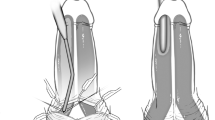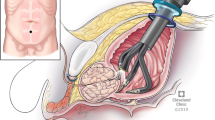Abstract
It is postulated that intraoperative injury to the cavernosal nerves results in hemodynamic and histologic changes within the penis, which manifest clinically as ED. We hypothesize that non-neuronal cause, such as vascular insults due to intraoperative tissue handling, may also have a minor but definite role in penile ischemia and consequent postoperative sexual dysfunction. Between May 2008 and July 2008, 64 patients were enrolled in the study (group 1). Following sterilization, the Odissey Tissue Oximeter probe was placed on the shaft of the penis, 2 cm from its base. The patient underwent continuous penile tissue saturation monitoring. Surgical dissection was altered whenever the oxygen saturation alarm went off until it was restored to ⩾85%. In addition, 192 patients, matched for age, preoperative prostate-specific antigen, clinical stage, baseline sexual function, Charlson comorbidity index and nerve-sparing status operated between October 2007 and July 2008, formed the control group (group 2). These patients did not have any intraoperative tissue oxygenation monitoring. Opening of the endopelvic fascia and steps of nerve sparing were associated with significant drops in oxygen levels, especially if done using torque. Drop in oxygen levels were also noted whenever excessive traction was applied on the Foley catheter, seminal vesicles or prostate during apical dissection. We deliberately modified our surgical steps to make surgery more traction free. A significantly higher percentage of group 1 patients with bilateral nerve sparing had no ED compared with group 2 patients at 6 weeks (24.5% vs 10.4%; P=0.014) and 52 weeks (83.7% vs 68%; P=0.029). Overall, 93.9% of patients in study group had Sexual Health Inventory for Men (SHIM) score of ⩾17 (mild to no ED) at 1 year compared with 78.4% of patients in the control group. We demonstrated that avoidance of ischemic stress, aided by intraoperative penile oxygenation monitoring, may help surgeons improve their technique and thus functional outcomes in patients.
This is a preview of subscription content, access via your institution
Access options
Subscribe to this journal
Receive 8 print issues and online access
$259.00 per year
only $32.38 per issue
Buy this article
- Purchase on Springer Link
- Instant access to full article PDF
Prices may be subject to local taxes which are calculated during checkout



Similar content being viewed by others
References
Stanford JL SR, Coyle LM, Cerhan J, Correa R, Eley JW, Gilliland F et al. Prostate Canc Trends 1973–1995, SEER Program, National Cancer Institute. NIH Pub. No. 99-4543. Bethesda, MD 1999.
Ruiz-Aragon J, Marquez-Pelaez S, Luque Romero LG . [Erectile dysfunction in patients with prostate cancer who have undergone surgery: systematic review of literature]. Actas Urol Esp 2010; 34: 677–685.
McCullough AR . Rehabilitation of erectile function following radical prostatectomy. Asian J Androl 2008; 10: 61–74.
Lue TF, Takamura T, Schmidt RA, Tanagho EA . Potential preservation of potency after radical prostatectomy. Urology 1983; 22: 165–167.
Kundu SD, Roehl KA, Eggener SE, Antenor JA, Han M, Catalona WJ . Potency, continence and complications in 3477 consecutive radical retropubic prostatectomies. J Urol 2004; 172 (6 Part 1): 2227–2231.
Haffner MC, Landis PK, Saigal CS, Carter HB, Freedland SJ . Health-related quality-of-life outcomes after anatomic retropubic radical prostatectomy in the phosphodiesterase type 5 ERA: impact of neurovascular bundle preservation. Urology 2005; 66: 371–376.
Catalona WJ, Carvalhal GF, Mager DE, Smith DS . Potency, continence and complication rates in 1870 consecutive radical retropubic prostatectomies. J Urol 1999; 162: 433–438.
Magheli A, Burnett AL . Erectile dysfunction following prostatectomy: prevention and treatment. Nat Rev Urol 2009; 6: 415–427.
Droupy S, Hessel A, Benoit G, Blanchet P, Jardin A, Giuliano F . Assessment of the functional role of accessory pudendal arteries in erection by transrectal color Doppler ultrasound. J Urol 1999; 162: 1987–1991.
Srivastava A, Grover S, Sooriakumaran P, Tan G, Takenaka A, Tewari AK . Neuroanatomic basis for traction-free preservation of the neural hammock during athermal robotic radical prostatectomy. Curr Opin Urol 2011; 21: 49–59.
McCullough A, Woo K, Telegrafi S, Lepor H . Is sildenafil failure in men after radical retropubic prostatectomy (RRP) due to arterial disease? Penile duplex Doppler findings in 174 men after RRP. Int J Impot Res 2002; 14: 462–465.
Mulhall JP, Graydon RJ . The hemodynamics of erectile dysfunction following nerve-sparing radical retropubic prostatectomy. Int J Impot Res 1996; 8: 91–94.
Keller A . Noninvasive tissue oximetry for flap monitoring: an initial study. J Reconstr Microsurg 2007; 23: 189–197.
Padmanabhan P, McCullough AR . Penile oxygen saturation in the flaccid and erect penis in men with and without erectile dysfunction. J Androl 2007; 28: 223–228.
Rosen RC, Cappelleri JC, Smith MD, Lipsky J, Pena BM . Development and evaluation of an abridged, 5-item version of the International Index of Erectile Function (IIEF-5) as a diagnostic tool for erectile dysfunction. Int J Impot Res 1999; 11: 319–326.
Martinez-Salamanca JI, Rao S, Ramanathan R, Tewari A . Robotic radical prostatectomy: Cornell University Technique (ART, Athermal Robotic Technique)]. Arch Esp Urol 2007; 60: 383–396.
Tewari A, Rao S, Martinez-Salamanca JI, Leung R, Ramanathan R, Mandhani A et al. Cancer control and the preservation of neurovascular tissue: how to meet competing goals during robotic radical prostatectomy. BJU Int 2008; 101: 1013–1018.
Tewari AK, Srivastava A, Mudaliar K, Tan GY, Grover S, El Douaihy Y et al. Anatomical retro-apical technique of synchronous (posterior and anterior) urethral transection: a novel approach for ameliorating apical margin positivity during robotic radical prostatectomy. BJU Int 2010; 106: 1364–1373.
Takenaka A, Leung RA, Fujisawa M, Tewari AK . Anatomy of autonomic nerve component in the male pelvis: the new concept from a perspective for robotic nerve sparing radical prostatectomy. World J Urol 2006; 24: 136–143.
Breza J, Aboseif SR, Orvis BR, Lue TF, Tanagho EA . Detailed anatomy of penile neurovascular structures: surgical significance. J Urol 1989; 141: 437–443.
Azadzoi KM, Golabek T, Radisavljevic ZM, Yalla SV, Siroky MB . Oxidative stress and neurodegeneration in penile ischaemia. BJU Int 2010; 105: 404–410.
Sayre LM, Smith MA, Perry G . Chemistry and biochemistry of oxidative stress in neurodegenerative disease. Curr Med Chem 2001; 8: 721–738.
Guo ZL, Longhurst JC . Role of cAMP in activation of ischemically sensitive abdominal visceral afferents. Am J Physiol Heart Circ Physiol 2000; 278: H843–H852.
Azadzoi KM, Goldstein I, Siroky MB, Traish AM, Krane RJ, Saenz de Tejada I . Mechanisms of ischemia-induced cavernosal smooth muscle relaxation impairment in a rabbit model of vasculogenic erectile dysfunction. J Urol 1998; 160 (6 Part 1): 2216–2222.
Azadzoi KM, Master TA, Siroky MB . Effect of chronic ischemia on constitutive and inducible nitric oxide synthase expression in erectile tissue. J Androl 2004; 25: 382–388.
Fraiman MC, Lepor H, McCullough AR . Changes in penile morphometrics in men with erectile dysfunction after nerve-sparing radical retropubic prostatectomy. Mol Urol 1999; 3: 109–115.
Moreland RB . Is there a role of hypoxemia in penile fibrosis: a viewpoint presented to the Society for the Study of Impotence. Int J Impot Res 1998; 10: 113–120.
McCullough A . Penile change following radical prostatectomy: size, smooth muscle atrophy, and curve. Curr Urol Rep 2008; 9: 492–499.
Tal R, Valenzuela R, Aviv N, Parker M, Waters WB, Flanigan RC et al. Persistent erectile dysfunction following radical prostatectomy: the association between nerve-sparing status and the prevalence and chronology of venous leak. J Sex Med 2009; 6: 2813–2819.
Tewari AK, Patel ND, Leung RA, Yadav R, Vaughan ED, El-Douaihy Y et al. Visual cues as a surrogate for tactile feedback during robotic-assisted laparoscopic prostatectomy: posterolateral margin rates in 1340 consecutive patients. BJU Int 2010; 106: 528–536.
Pick DL, Osann K, Skarecky D, Narula N, Finley DS, Ahlering TE . The impact of cavernosal nerve preservation on continence after robotic radical prostatectomy. BJU Int; published online 18 January 2011 (e-pub ahead of print).
Choi WW, Freire MP, Soukup JR, Yin L, Lipsitz SR, Carvas F et al. Nerve-sparing technique and urinary control after robot-assisted laparoscopic prostatectomy. World J Urol 2011; 29: 21–27.
Srivastava A, Grover S, Sooriakumaran P, Joneja J, Tewari AK . Robotic-assisted laparoscopic prostatectomy: a critical analysis of its impact on urinary continence. Curr Opin Urol 2011; 21: 185–194.
Author information
Authors and Affiliations
Corresponding author
Ethics declarations
Competing interests
The authors declare no conflict of interest.
Rights and permissions
About this article
Cite this article
Tewari, A., Srivastava, A., Sooriakumaran, P. et al. Technique of traction-free nerve-sparing robotic prostatectomy: delicate tissue handling by real-time penile oxygen monitoring. Int J Impot Res 24, 11–19 (2012). https://doi.org/10.1038/ijir.2011.40
Received:
Revised:
Accepted:
Published:
Issue Date:
DOI: https://doi.org/10.1038/ijir.2011.40
Keywords
This article is cited by
-
The Effect of Major Pelvic Extirpative Surgery on Lower Urinary Tract Function
Current Bladder Dysfunction Reports (2019)
-
A prediction model relating the extent of intraoperative fascia preservation to erectile dysfunction after nerve-sparing robot-assisted radical prostatectomy
Journal of Robotic Surgery (2019)
-
Functional outcomes following robotic prostatectomy using athermal, traction free risk-stratified grades of nerve sparing
World Journal of Urology (2013)



